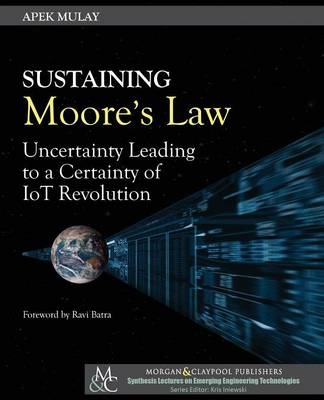
Sustaining Moore's Law
Morgan and Claypool Life Sciences (Verlag)
978-1-62705-810-0 (ISBN)
While Moore's Law has, on one hand, helped drive investments toward technological and economic growth, thereby benefiting the consumers with more powerful electronic gadgets, Moore's Law has indirectly also helped to fuel other innovations in the global economy. However, the Law of diminishing returns is now questioning the sustainability of further evolution of Moore's Law and its ability to sustain the progress of today's knowledge based economy. The lack of liquidity in the global economy is truly bringing the entire industry to a standstill and the dark clouds of an economic depression are hovering over the global economy.
What factors have been ignored by the global semiconductor industry leading to a demise of Moore's Law? Do the existing business models prevalent in the semiconductor industry pose any problems? Have supply chains made that progress unsustainable? In today's globalized world, have businesses been able to sustain national interests while driving the progress of Moore's Law? Could the semiconductor industry help the entire global economy move toward a radiance of the new crimson dawn, beyond the veil of the darkest night by sustaining the progress of Moore's Law?
The entire semiconductor industry is now clamoring for a fresh approach to overcome existing barriers to the progress of Moore's Law, and this book delivers just that. Moore's Law can easily continue for the foreseeable future if the chip manufacturing industry becomes sustainable by having a balanced economy. The sustainable progress of Moore's Law advocates the "heresy" of transforming the current economic orthodoxy of monopoly capitalism into free-market capitalism. The next big thing that everybody is looking forward to after mobile revolution is the "Internet of Things" (IoT) revolution. While some analysts forecast that the IoT market would achieve 5.4 billion connections worldwide by 2020, the poor consumer purchasing power in global economy makes this forecast truly questionable. Sustaining Moore's Law presents a blueprint for sustaining the progress of Moore's Law to bring about IoT Revolution in the global economy.
Apek Mulay is a business and technology consultant with Mulay's Consultancy Services. He is author of two books Mass Capitalism: A Blueprint for Economic Revival and Sustaining Moore's Law: Uncertainty Leading to a Certainty of IoT Revolution. He pursued undergraduate studies in electronics engineering (EE) at the University of Mumbai in India, and has completed a master's degree in EE at Texas Tech University, Lubbock. He is sole author of a patent Surface Imaging with Materials Identified by Colors, developed during his employment in Advanced CMOS technology development team at Texas Instruments Inc. Mr. Mulay has chaired technical sessions at the International Symposium for Testing and Failure Analysis (ISTFA) for consecutive years 2009 and 2010. He has also authored several articles in reputed publications, showing this wide expertise in macroeconomics, geo-politics, supply chains, business models, socio economics, and microeconomics, relating these to the capital-intensive semiconductor industry. USCIS approved his US permanent residency under the category of foreign nationals with extraordinary abilities in science and technologies, even though he did not pursue a Ph.D. in either engineering or economics. He contributes to several recognized publications, such as EBN, Truthout site, electronics publications site, EDFA magazine, Military & Aerospace Electronics Magazine (MA&E), SEMI site, LinkedIn, etc. His blog has reached close to 2 million hits since he started blogging in May 2013.
Foreword
Preface
Acknowledgments
Impacts of Moore's Law on Human Progress
From an Unsustainable to a Sustainable Progress of Moore's Law
Impacts of Semiconductor Business Models on U.S. National Interests
Impacts of Semiconductor Business Models on Sustainability
Macroeconomic Cycles and Business Models for the Progress of Moore's Law
Would Economics End Moore's Law?
Design of Supply Chains for the Success of the Internet of Things (IoT)
The Macroeconomics of 450 mm Wafers
Moore's Law Beyond 50
Macroeconomics of Semiconductor Manufacturing for Emerging Economies
The Internet of Things (IoT) Revolution
An Engagement with Semiconductor Industry Thought Leaders about the Future of the Semiconductor Industry
Author's Biography
| Erscheinungsdatum | 18.03.2016 |
|---|---|
| Reihe/Serie | Synthesis Lectures on Emerging Engineering Technologies |
| Verlagsort | San Rafael, CA |
| Sprache | englisch |
| Maße | 191 x 235 mm |
| Gewicht | 333 g |
| Themenwelt | Technik ► Elektrotechnik / Energietechnik |
| ISBN-10 | 1-62705-810-9 / 1627058109 |
| ISBN-13 | 978-1-62705-810-0 / 9781627058100 |
| Zustand | Neuware |
| Haben Sie eine Frage zum Produkt? |
aus dem Bereich


